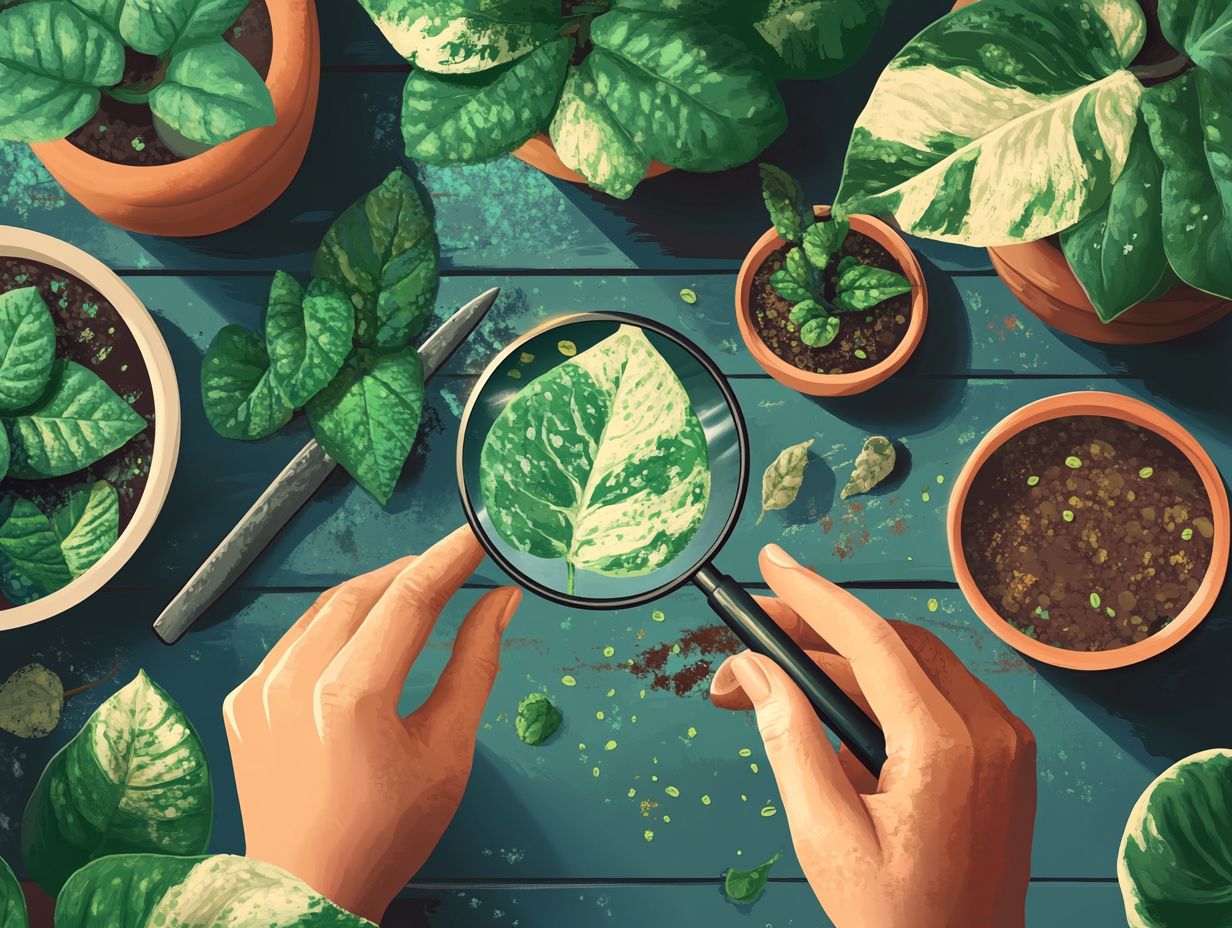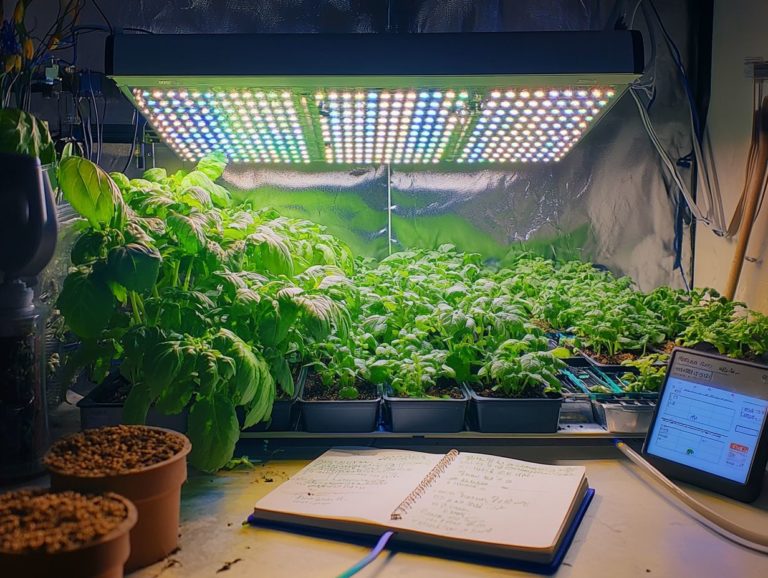How to Diagnose and Treat Plant Diseases
Plants can be susceptible to a range of diseases, significantly affecting their health and aesthetic appeal.
Grasping the various types of plant diseases is crucial for any gardener or plant enthusiast. This article delves into how to identify common symptoms, apply diagnostic techniques, and implement effective treatment methods.
You ll also discover preventive strategies to keep your plants flourishing and learn when to consult a professional for more serious cases. Prepare to enhance your knowledge and safeguard your green companions!
Contents
- Key Takeaways:
- Understanding Plant Diseases
- Identifying Plant Diseases
- Diagnosing Plant Diseases
- Treating Plant Diseases
- Effective Treatment Methods
- Preventing Plant Diseases
- Dealing with Severe Cases
- Frequently Asked Questions
- What are some common signs of plant diseases, including rust plant disease and powdery mildew?
- How can I accurately diagnose a plant disease, including downy mildew or anthracnose?
- What are some possible causes of plant diseases, such as mosaic viruses or fungal diseases?
- What is the best way to treat plant diseases and manage conditions like white mold or blossom-end rot?
- Can plant diseases be prevented through effective preventive measures and crop rotation?
- Are there any natural remedies for treating plant diseases, including fungicide alternatives?
Key Takeaways:

Properly identifying plant diseases is essential for effective treatment. Look for common symptoms and signs such as wilting, discoloration, and deformities.
Utilize appropriate diagnostic techniques and tools to accurately diagnose plant diseases. This could include soil testing, plant tissue analysis, and laboratory testing.
Prevention is key in managing plant diseases. Implement preventive measures like crop rotation, proper watering, and good ventilation to keep your plants healthy.
Understanding Plant Diseases
Knowing about plant diseases can be a game changer for your garden! Whether you’re an amateur gardener or a professional farmer, understanding plant diseases directly influences the healthy growth and quality of your crops. These diseases can arise from various germs like fungi (tiny organisms that can cause disease in plants), bacteria, and viruses that jeopardize your plants’ well-being.
By familiarizing yourself with these diseases, you empower yourself to take proactive measures to identify, diagnose, and treat symptoms effectively, ensuring your garden or agricultural operation remains productive and resilient. This knowledge also helps you implement strategies that prevent disease outbreaks, safeguarding your crops from potential devastation.
Types of Plant Diseases
You ll encounter various types of plant diseases, each caused by distinct disease-causing agents that threaten crop health and productivity worldwide. Fungal diseases like anthracnose, downy mildew, and powdery mildew are particularly prevalent. Viral infections, such as mosaic viruses, can lead to substantial yield losses. Challenges also arise from conditions like early blight, rust plant disease, and white mold, all of which test a grower’s commitment to maintaining high-quality crops.
To effectively manage these diseases, understanding their underlying causes is crucial. Take anthracnose, for example; it often emerges when it s very humid, presenting as dark lesions on leaves that undermine the plant’s vigor. Downy mildew, in contrast, thrives in moist environments, leading to yellowing leaves and stunted growth. Early blight, mainly affecting tomatoes and potatoes, shows up as brown spots surrounded by yellow halos.
By recognizing these symptoms of infection early, you can take proactive measures to mitigate their spread, ensuring your crops retain their yield and crop quality.
Identifying Plant Diseases
Identifying plant diseases is an essential step in ensuring the health of your crops and curbing the further spread of pathogens. This process requires keen observation of infection symptoms, which can manifest in diverse ways, from wilting leaves to peculiar spots or discoloration.
As a gardener or farmer, tapping into resources like local university extension services can significantly enhance your ability to accurately diagnose and identify plant diseases. By familiarizing yourself with specific symptoms linked to various diseases, you can customize your treatment and prevention strategies effectively.
Common Symptoms and Signs
Common symptoms of plant diseases can appear in many ways. These signs often reveal deeper issues such as fungal infections, nutrient deficiencies, or environmental stress. For example, blossom-end rot suggests a calcium deficiency, while grayish-white spots on leaves might indicate downy mildew.
Leaf curl may indicate problems related to viral infections or pest damage, which can distort growth patterns. Wilting leaves, often attributed to drought, might actually suggest root rot due to excessive moisture and poor drainage.
Chlorosis, marked by yellowing leaves, can stem from inadequate nitrogen levels or iron deficiency. Understanding these symptoms allows you to diagnose and address problems early, creating a healthier environment for your plants.
Diagnosing Plant Diseases

Accurately diagnosing plant diseases is crucial for effective management. This process involves using a range of diagnostic techniques and tools, from visual inspections and soil pH testing to lab analyses when necessary.
Using the right gardening tools and agricultural sprayers enhances your ability to apply targeted treatments. Consider using fungicide alternatives that provide safer options for managing fungal diseases.
Diagnostic Techniques and Tools
Many diagnostic techniques and tools help effectively identify plant diseases. Visual inspections serve as your first line of defense, allowing you to examine leaves and stems for visible symptoms like spots or mold.
Tools like soil pH meters and agricultural sprayers improve your ability to diagnose and treat diseases. Among these, hand-held magnifying lenses allow for closer examination, helping you spot pests or fungal growth that may be hard to see.
Diagnostic kits often include PCR (a method to quickly identify plant diseases) tests, providing rapid identification of pathogens by amplifying their DNA. Additionally, remote sensing technology, including drones with multispectral cameras, allows monitoring of larger areas for stress indicators, facilitating early intervention.
Using these diagnostic techniques can help you manage plant health, improve crop yield, and minimize economic losses.
Treating Plant Diseases
Addressing plant diseases effectively is essential for maintaining your crops and ensuring the longevity of your healthy plants. A range of treatments is available, including anthracnose treatment methods, downy mildew treatments, and various fungicide alternatives.
By understanding how to treat symptoms, you facilitate recovery and reduce the risk of further infections. Act now to protect your plants and allow them to truly flourish!
Effective Treatment Methods
Treating plant diseases effectively requires a thoughtful blend of chemical and organic approaches tailored to the specific symptoms and pathogens affecting your plants. Use agricultural sprayers to apply gentler fungicide alternatives that protect beneficial insects and the environment while managing diseases effectively. By identifying the right treatment, you can address symptoms appropriately, promoting recovery and fostering healthy plant growth.
Integrating pest management techniques will enhance your plant health by reducing chemical use and incorporating biocontrol agents like beneficial nematodes or predatory insects. Products such as neem oil and potassium bicarbonate are excellent solutions for fighting fungal infections. Additionally, practices like crop rotation and choosing resistant plant varieties serve as proactive measures.
Regular monitoring and timely application of these strategies tackle current issues and enhance resilience against future outbreaks. This approach nurtures a thriving, sustainable ecosystem in your garden or farm, ensuring your plants flourish beautifully.
Preventing Plant Diseases
Preventing plant diseases is vital for you as a gardener or farmer. It emphasizes the importance of nurturing healthy growth while minimizing the risk of infections from plant pathogens.
Key measures to consider include:
- Closely monitoring soil pH
- Managing humidity levels carefully
- Employing crop rotation strategies to disrupt disease cycles effectively
By proactively addressing these factors, you can significantly reduce the chances of outbreaks and promote robust plant health throughout the growing season, particularly against calcium deficiency and humid conditions.
Preventive Measures and Tips

Implementing preventive measures is essential for protecting your plants from diseases and ensuring healthy growth. Regularly check the soil pH to maintain optimal levels, manage humidity in the growing environment, and practice good hygiene with your gardening tools to minimize the introduction of plant pathogens. These proactive steps shield your plants and bolster their resilience against potential disease outbreaks.
Crop rotation significantly aids in disease prevention by disrupting pest and pathogen life cycles. Consider companion planting techniques, allowing older plants to support younger ones and creating natural barriers against infestations. Incorporate organic mulch to stabilize soil temperature and moisture, both crucial for root health.
To further defend against pests, explore using natural repellents like neem oil or insecticidal soap, targeting harmful insects without harming the beneficial ones. By integrating these strategies, you cultivate a thriving, disease-free ecosystem in your garden or farm.
Dealing with Severe Cases
Act quickly when facing severe plant disease to prevent further damage! Consult local university extension services or certified experts for precise plant diagnoses and effective treatment suggestions.
Timely intervention is essential for managing serious infections and safeguarding the health of your remaining plants from potential compromise.
Start implementing these strategies today to ensure vibrant and resilient plants in your garden!
When to Seek Professional Help
Knowing when to seek professional assistance is essential for effectively managing severe cases of plant diseases. If you notice a rapid decline in plant health, extensive symptoms, or an outbreak that seems uncontrollable, don t wait; consult an expert now!
If your once-thriving garden is suddenly marred by unusual leaf discoloration or a pest invasion, reach out to a certified plant expert or local gardening help. They can help identify the issue and provide tailored strategies to combat it.
These professionals often have access to advanced diagnostic tools and research-backed insights that a home gardener may lack. Local agricultural cooperatives frequently offer workshops and resources to empower you with knowledge on sustainable practices to prevent future outbreaks.
By engaging with professional services, you address immediate concerns while investing in the long-term health of your plants and the stability of your ecosystem.
Frequently Asked Questions
What are some common signs of plant diseases, including rust plant disease and powdery mildew?
Common signs of plant diseases include wilting, yellowing or browning of leaves, spots or lesions on leaves, and stunted growth.
How can I accurately diagnose a plant disease, including downy mildew or anthracnose?

To accurately diagnose a plant disease, observe the affected plant and its symptoms carefully. You can also consult a local plant expert or bring a sample to a plant clinic for diagnosis.
What are some possible causes of plant diseases, such as mosaic viruses or fungal diseases?
Plant diseases can result from various factors, including fungal or bacterial infections, environmental stressors, nutrient deficiencies, and pest infestations.
What is the best way to treat plant diseases and manage conditions like white mold or blossom-end rot?
The best treatment for plant diseases depends on the specific disease and its severity. Common methods include removing infected plant parts, using organic or chemical pesticides, and improving growing conditions.
Can plant diseases be prevented through effective preventive measures and crop rotation?
Yes, plant diseases can often be prevented by practicing good plant care and maintenance, such as providing proper water and sunlight, regularly cleaning and sanitizing gardening tools, and avoiding overcrowding of plants.
Are there any natural remedies for treating plant diseases, including fungicide alternatives?
Yes, various natural remedies can be used, such as neem oil, garlic spray, and compost tea. These remedies are generally safer for the environment and can be effective against certain plant diseases.
Take action today to protect your plants!






